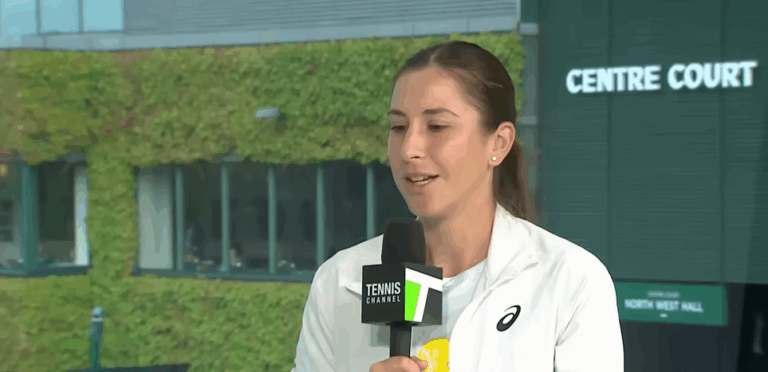Less than a year after giving birth to her daughter Bella, Belinda Bencic returned to the top level of tennis, demonstrating not only her physical stamina but also her emotional depth. Bella and her partner, Martin Hromkovic, who also serves as her fitness coach, travel together, and Bencic has made professional tennis a surprisingly peaceful family affair. Her off-court presence has softened in a way that feels grounded and incredibly human, and her performances since giving birth have been noticeably sharp.
Bencic and Bella have been spotted together at Wimbledon in recent months, particularly during the summer months, where they have been spotted walking the practice courts and giving her team strawberries. These seemingly straightforward occasions have come to represent her metamorphosis. Motherhood has given her remarkable emotional resilience and new clarity, rather than weakening her competitive edge. She now performs to inspire—to herself, her daughter, and the audience—rather than to prove a point.
Bencic has gracefully embraced her roles as a mother and a competitor since Bella arrived in April 2024. She had already resumed playing in tournaments by October of the same year, only six months after giving birth. Her competitive rhythm was rekindled and a more comprehensive approach to performance was shaped by that quick transition, which was emotionally and physically taxing. She now sees tennis as a powerful component of a much bigger picture rather than her entire identity.
Belinda Bencic – Bio & Career Summary
| Detail | Information |
|---|---|
| Full Name | Belinda Bencic |
| Date of Birth | March 10, 1997 |
| Age | 28 |
| Nationality | Swiss |
| Residence | Wollerau, Switzerland |
| Height | 1.75 m (5 ft 9 in) |
| Turned Pro | 2012 |
| Playing Style | Right-handed (two-handed backhand) |
| Career Prize Money | $13,962,128 |
| Career Titles | 9 WTA Singles, 2 Doubles |
| Highest Singles Ranking | No. 4 (February 2020) |
| Current Singles Ranking | No. 20 (July 2025) |
| Olympic Medal | Gold (Tokyo 2021 – Singles), Silver (Doubles) |
| Daughter’s Name | Bella |
| Daughter’s Birth | April 2024 |
| Partner | Martin Hromkovic |
| Source | https://en.wikipedia.org/wiki/Belinda_Bencic |

Bencic won the Abu Dhabi Open in February 2025, her first WTA championship since having a child. The triumph had profound symbolic meaning. It not only demonstrated her increased consistency and skillful shot selection, but it also signaled the beginning of a new chapter—a victory gained while juggling sleepless nights and traveling with a toddler. The outcome was hailed as a breakthrough for women’s tennis in general as well as for Bencic specifically. For athletes thinking about becoming mothers without compromising their goals, her story has become especially inspirational.
Although women’s tennis has been progressively accepting players returning from maternity leave over the last ten years, Bencic’s story adds something particularly compelling. Her comeback has been subtly remarkable in contrast to the more well-known ones of athletes like Serena Williams or Victoria Azarenka. She has avoided burnout by concentrating on steady advancement, demonstrating that longevity can be sustainably fostered with deliberate pacing and organized support networks.
A key figure in this journey has been her partner, Martin Hromkovic, a former football player who is now a conditioning coach. Working closely with Bencic on a personal and professional level, he has contributed to the development of an extremely effective rhythm. Their coordination has been remarkably adaptable, ranging from planning recovery exercises with postpartum physiology in mind to arranging training around nap times. Together, they have created a model that illustrates how integrated planning can completely enable high-performance parenting.
Bella has not been concealed by hotel walls or social media filters during this chapter. Bencic has instead decided to publicly celebrate her daughter’s arrival, and this openness has struck a chord with many people. Bella’s beaming face turned into a subdued yet potent symbol at Wimbledon, reminding spectators that even the most competitive sports can be enjoyed by the whole family. Her chubby fingers wrapped around a tennis ball and her soft giggle in the player’s box suggested that the sport’s tone had significantly improved—more relatability, more warmth.
Bencic has frequently talked about how having Bella by her side helps her cope with stress in post-match interviews. When a baby is waiting with open arms, losses don’t linger as long. Conversely, victories seem more significant. Her performances have become even more emotionally charged as a result of this duality—the contrast between fierce competition and loving motherhood—especially during lengthy tournament runs. Her performance in the semifinals of the 2025 Wimbledon Championships was driven by a remarkably clear sense of purpose in addition to her form.
The conversation in society about working mothers, especially those in high-level occupations, has significantly grown in the last 12 months. Bencic’s example highlights a more general reality: professional success can flourish without a pause in personal life. Rather, they can develop together with deliberate assistance and unambiguous values. Not only is she coming back to compete, but she is also establishing a standard for what an integrated, balanced athletic life can actually entail.
It’s also critical to acknowledge that she has faced difficulties along the way. Bencic has admitted that her routine is more taxing, involving everything from coordinating travel arrangements with a small child to modifying sleep cycles and recuperation windows. She describes the chaos as surprisingly rewarding, but she approaches these changes with optimism. She has created a career that now embraces love, flexibility, and constant reinvention in addition to rankings through strategic adaptability.
Bella might not recall her early courtside experiences in the years to come, but she will know that her mother played tennis with tenacity, poise, and remarkable balance. More significantly, she will understand that achieving greatness does not require compromising one’s happiness. Perhaps more enduring than any trophy is that lesson, which was subtly transmitted from mother to daughter.


